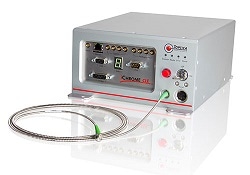TOPTICA’s new laser combiner engine iChrome CLE includes four laser sources in one compact box.

TOPTICA’s new laser combiner engine iChrome CLE includes four laser sources in one compact box. It provides up to 20 mW of output power at 405, 488, 561 and 640 nm each. All integrated wavelengths are controllable via a unified user interface (analog and digital inputs, as well as RS232 and Ethernet).
TOPTICA also provides a ready-to-use, user-friendly control software and a powerful command set for full OEM integration.The multi-laser system features unique modulation capabilities up to 1 MHz analog and digital modulation frequency. TOPTICA’s automated alignment procedure COOLAC guarantees a straightforward plug & play installation and an unsurpassed stability over the system’s lifetime.
The iChrome CLE is the first all-diode laser combiner, including a diode-based 561 nm FDDL (Frequency Doubled Diode Laser) laser source. This unique design guarantees identical modulation behavior for all laser lines. Complete-Off is another advantage of this all-diode design, since it guarantees that all lasers including the 561 nm line do not emit any residual light in the ”Off” state – even if modulated at 1 MHz.
Providing 405, 488, 561 and 640 nm, the iChrome CLE is an excellent laser light source for microscopy, especially optimized for confocal microscopy. The combination of these colors enables excitation of the majority of popular fluorophores with only one fully integrated device. The small footprint, low heat load and low power consumption make the iChrome CLE very economic and easy to integrate.
The iChrome CLE is the third member of TOPTICA’s “iChrome” product line. This portfolio includes the compact and economic iChrome CLE with four pre-defined colors, the iChrome MLE with four selectable colors, as well as the iChrome SLE that integrates up to 8 exchangeable colors. All iChrome systems have a unified user interface, unique modulation skills and an automated alignment algorithm. They are ideal tools for a broad variety of biophotonics applications, including microscopy, flow-cytometry and high-content screenin